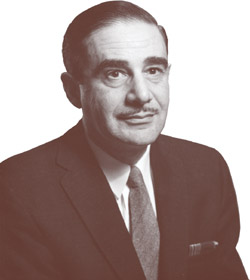
Franz Boas has been called "the father of American anthropology." Known for his extensive field work with the Kwakiutl Indians from Vancouver Island, Boas went on to establish a new concept of race that drew a distinction between biology and culture. A prolific author, his work influenced an entire generation of anthropologists—including Jacobs and other former students such as Margaret Mead. Typical of senior professors, Boas frequently dispatched graduate students to perform field work in support of his research, which is how Jacobs found himself in Eastern Washington in 1926. Later, describing Jacobs as "by far the best man I have had for many years," Boas recommended his protégé to the UW as an associate professor in anthropology. Thus began his 43-year career at the University.
Jacobs did all of his field work between 1926 and 1939, stopping primarily because "he had accumulated more stuff than he'd ever be able to publish," says Bill Seaburg, an associate professor of interdisciplinary arts and sciences at UW Bothell and an expert on Jacobs' research. During this time—which coincided with the Depression—Jacobs relied heavily on grants secured by Boas, whose public and private financial connections made him "a real power broker," says Seaburg. In addition, Jacobs also counted on the cooperation of the UW, which let him split his time between teaching and field research.
Without being able to ask Jacobs directly, it's hard for anyone to say why he devoted so much of his life to studying and preserving the languages of Pacific Northwest tribes. Some have speculated his own Jewish heritage sensitized him to the plight of maligned minority cultures. Seaburg suspects it was probably Boas who ignited his interest in documenting the region's disappearing native languages. "There were few people in the country, outside of anthropology, who believed in the intrinsic value of unrecorded languages and oral traditions when Jacobs was doing his field work and Boas and his many students led the way in championing these disparaged and threatened cultures," says Seaburg.
In some ways, Jacobs seemed unsuited for the rigors of traveling to remote reservations and spending long hours interviewing tribal elders. "Anyone who knew Melville Jacobs, fastidious in dress and grooming, cultivated and witty, always had difficulty imagining him coping with bad roads, seedy hotels and truck-stop food," wrote Seaburg in a book on the Jacobs collection.
Even so, Jacobs also possessed a number of traits that served him well in the field, says Seaburg. "I think he had a way with people that would help them feel at ease," he says. "He had a good sense of humor and a really good ear for the spoken word." Not only that, "he had beautiful handwriting," says Seaburg.

Melville Jacobs. Photo by James Sneddon. Courtesy of MSCUA, University of Washington Libraries, Neg # Info. Services 57708.
One of the biggest challenges facing Jacobs is that the 26 letters of the English alphabet fail to reflect all of the sounds of Native American languages. Jacobs responded by employing an enhanced alphabet with additional symbols. Once satisfied that his pencil and paper version was phonetically authentic, he would read the words back to his subjects and ask them to translate them into English. Today, a linguist would undoubtedly use a tape recorder. However, when Jacobs was doing his research, audio technology was still very crude. Plus Jacobs was biased. "He always felt it was kind of lazy to do it that way," says Seaburg. "He thought it was more important to learn how to listen."
While Jacobs did make some recordings—copies reside in the School of Music Ethnomusicology Archives—they consist mostly of short songs as the wax and later vinyl cylinders originally used to produce the recordings were of extremely limited duration. Later he also recorded on 78 rpm disks.
Nevertheless, the brief and scratchy recordings, cleaned up and transferred onto lengthy reel-to-reel tapes, are valuable supplements to the rest of the Jacobs Collection, says Seaburg. "You can come pretty close to reproducing the sounds by reading the symbols, but you miss the intonation," he says.Even more, the recordings also ignite the spirit of those who listen to the tapes and sense the presence of their ancestors. "I could feel it," says Kalama-Miller, shaking her arm.
Kalama-Miller was just one of many Breath of Life participants who listened to the recordings. Some were surprised to hear family members, says Laurel Sercombe, ethnomusicology archivist. "I heard people saying, 'Oh my God! That's my great grandfather.' "
Such powerful personal reactions give Sercombe "mixed feelings about the whole academic collecting tradition." Of course, if scholars had not taken and preserved pieces of Native American culture, "there might not be much left," she says.
Go To: Page 1 | Page 2 | Page 3
- Return to December 2003 Table of Contents